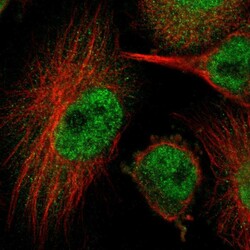Antibody data
- Antibody Data
- Antigen structure
- References [3]
- Comments [0]
- Validations
- Immunocytochemistry [1]
Submit
Validation data
Reference
Comment
Report error
- Product number
- HPA002548 - Provider product page

- Provider
- Atlas Antibodies
- Proper citation
- Atlas Antibodies Cat#HPA002548, RRID:AB_1080489
- Product name
- Anti-HUWE1
- Antibody type
- Polyclonal
- Description
- Polyclonal Antibody against Human HUWE1, Gene description: HECT, UBA and WWE domain containing 1, E3 ubiquitin protein ligase, Alternative Gene Names: Ib772, KIAA0312, UREB1, Validated applications: ICC, IHC, Uniprot ID: Q7Z6Z7, Storage: Store at +4°C for short term storage. Long time storage is recommended at -20°C.
- Reactivity
- Human
- Host
- Rabbit
- Conjugate
- Unconjugated
- Isotype
- IgG
- Vial size
- 100 µl
- Concentration
- 0.1 mg/ml
- Storage
- Store at +4°C for short term storage. Long time storage is recommended at -20°C.
- Handling
- The antibody solution should be gently mixed before use.
Submitted references The E3 ubiquitin ligase HUWE1 acts through the N‐Myc‐DLL1‐NOTCH1 signaling axis to suppress glioblastoma progression
The E3 ligase HUWE1 inhibition as a therapeutic strategy to target MYC in multiple myeloma
Non-proteolytic ubiquitination of Hexokinase 2 by HectH9 controls tumor metabolism and cancer stem cell expansion
Yuan Y, Wang L, Zhao X, Wang J, Zhang M, Ma Q, Wei S, Yan Z, Cheng Y, Chen X, Zou H, Ge J, Wang Y, Zhang X, Cui Y, Luo T, Bian X
Cancer Communications 2022;42(9):868-886
Cancer Communications 2022;42(9):868-886
The E3 ligase HUWE1 inhibition as a therapeutic strategy to target MYC in multiple myeloma
Crawford L, Campbell D, Morgan J, Lawson M, Down J, Chauhan D, McAvera R, Morris T, Hamilton C, Krishnan A, Rajalingam K, Chantry A, Irvine A
Oncogene 2020;39(27):5001-5014
Oncogene 2020;39(27):5001-5014
Non-proteolytic ubiquitination of Hexokinase 2 by HectH9 controls tumor metabolism and cancer stem cell expansion
Lee H, Li C, Ruan D, He J, Montal E, Lorenz S, Girnun G, Chan C
Nature Communications 2019;10(1)
Nature Communications 2019;10(1)
No comments: Submit comment
Supportive validation
- Submitted by
- Atlas Antibodies (provider)
- Main image

- Experimental details
- Immunofluorescent staining of human cell line U-251 MG shows localization to nucleoplasm & cytosol.
- Sample type
- Human
 Explore
Explore Validate
Validate Learn
Learn Immunocytochemistry
Immunocytochemistry Immunohistochemistry
Immunohistochemistry